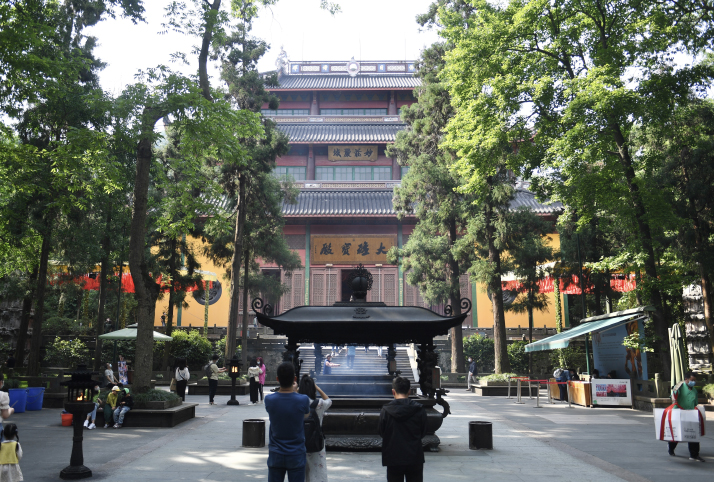| Lifestyle |
| A temple's tranquility | |
|
|
 The Hall of Mahavira at the Lingyin Temple in Hangzhou, Zhejiang Province (CNSPHOTO)
Hangzhou City, the capital of Zhejiang Province in east China known for its picturesque beauty, is home to the Lingyin Temple, one of China's most famous ancient Buddhist monasteries. Located in the hills of the Wulin Mountains, the temple is surrounded by lush greenery and tranquil streams that make it a popular destination for tourists seeking peace and serenity. The temple was founded in 326 during the Eastern Jin Dynasty. Throughout its lengthy history, it was destroyed and rebuilt several times, with the current structure dating to the Qing Dynasty (1644-1911). The temple complex covers an area of 87,000 square meters, comprising various halls, pagodas and grottoes. Legends associated with the site are numerous. One of the legends about the founding of the monastery tells how an Indian monk known by the Chinese name Huili was amazed by the splendor of the mountain landscape. He believed it to be the secret abode of a celestial being and therefore decided to build a monastery on a mountain slope called the Temple of the Soul's Retreat, a literal translation of "Lingyin Temple." One of the most notable features of the Lingyin Temple is its main hall, the Hall of the Four Heavenly Kings, four Buddhist deities, each of whom watching over one cardinal direction of the world. It houses magnificent statues of the Heavenly Kings, each standing at over 14 meters tall, and is adorned with intricate carvings and paintings depicting Buddhist legends and stories. Behind the Hall of the Four Heavenly Kings is the Hall of Mahavira, which is the central one in the complex. In the center of the hall is a golden statue of Buddha Shakyamuni seated on the lotus throne. With a height of 24.8 meters, it is one of the tallest wooden statues of a seated Buddha. Another highlight of the temple is the Flying Peak, located behind the temple. The peak is known for its more than 300 rock carvings, some of which date back to the 10th century. These carvings depict various Buddhist figures and scenes, as well as ancient Chinese myths and legends. The largest of them is the stout figure of the Laughing Buddha. People say "his stomach contains everything that is impossible to withstand in the whole world." I was also fascinated by the Hall of 500 Arhats, which contains bronze statues of Buddhist sages. The floor plan of the building is in the shape of a Buddhist swastika. The main hall contains a large statue of Buddha. It is surrounded by 500 life-size statues of arhats, or enlightened beings, each with a unique facial expression and posture. The arhats are arranged on pedestals along the walls of the hall in 10 rows, with 50 statues in each row. Each of the statues is made of wood and has been painted with vibrant colors and intricate details. The hall also features elaborate carvings and murals depicting scenes from Buddhist teachings and mythology. Its cultural and historical significance aside, the Lingyin Temple is also a popular place to go hiking and explore nature. A must for nature lovers and photographers, the surrounding mountains offer stunning views of the temple and the city of Hangzhou. Overall, the temple is a beautiful and serene destination that offers a glimpse into China's rich cultural and religious heritage. Its breathtaking architecture, stunning natural surroundings and peaceful atmosphere make it a perfect place to escape the hustle and bustle of modern life and find inner peace. The author is an Azerbaijani student at East China Normal University in Shanghai Copyedited by Elsbeth van Paridon Comments to yanwei@cicgamericas.com |
|
||||||||||||||||||||||||||||||
|